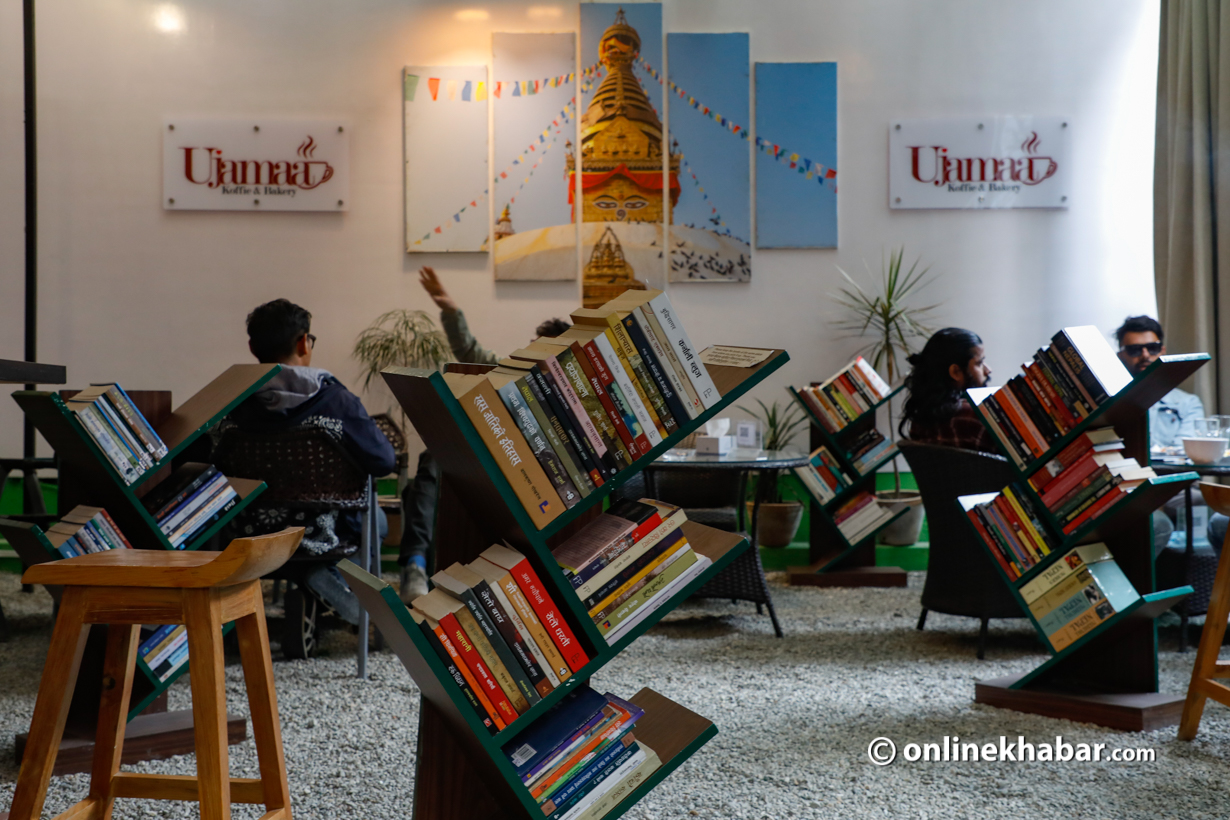‘Tribhuvan ki Erica’ was the book that intrigued Anne Tamang at first sight. She picked it up and sat down to read it. Page by page, she sat down for hours and even sipped a few cups of coffee. With her bookmark in place, she put the book back in its place and then came back the next day to continue the book.
This 26-year-old is a resident of Bhaktapur, yet she travels to Sankhamul of Kathmandu to read the book. But, she does not enter a library, rather she checks in at Ujamaa Koffie, a coffee shop at Sankhamul Chok and finds a corner to read her book. “The premise of the book got me intrigued and now I come here some twice or thrice a week to sit and read. I love the ambience here and the staff are welcoming,” says Tamang.
Tamang is among those young crowd in the Kathmandu valley who have found their haven in coffee shops or restaurants to read and socialise. “I used to go to another coffee shop at Purano Baneshwar, but that was before lockdown. Ever since I came to know about this place, I have been frequenting here and I love the whole experience.”
To give customers like Tamang the best of both worlds, a handful of coffee shops and restaurants have popped up within the valley that want to promote and preserve the reading culture. And so far, according to them, the reception has been positive and revering in the loyal customer base they have garnered with the concept.
Leaving one’s imprint

Though scattered throughout the valley, there is one thing that ties these places together; the owner’s love for books. “I have always been a reader. And I loved eating and baking too, so I had always thought I would create a space where both come together. Hence, Bodhi Bakes and Books became a reality,” shares Bidhushi Rana, who co-founded and manages the coffee shop with her husband.
Prajina Shrestha, the owner of Freak Street Kaffe in Basantapur, also shares a similar story, “Reading was a passion and with time I wanted to share that passion with others. So I brought together music, books and antiques in one space.”
On this, Tara Gurung, the owner of Mo:mo la Palpasa Coffee in Bhimsengola, adds, “The young crowd today rarely read books. And, I wanted to create a space where people can come, feel comfortable and read books rather than just spending their time on their mobile phones and the digital world.”
The concept of having books at coffee shops has not only been embraced by the new cafes, but old cafes have also rebranded themselves.
Ujamaa Koffee in Sankhamul started its operation just three months ago with the bookshelves and it has already garnered over 100 customer base, which its cofounder Upendra Rai says shows how people are welcoming the idea. “Some customers even have requested us to get certain books, and I take very positively.”
On the other side of the town, an eight-year-old BIA Cafe in Swayambhu has recently incorporated books as a part of the cafe and has been getting a positive response. The cafe’s managing director Ngawang Thapa says, “The new addition has been well received by the locals and the travellers too. And, we have seen a lot of faces that have been frequenting the cafe after we put up the bookshelves too.”
There are many other coffee shops and restaurants that have integrated books into their space to add value to their business. The collection–ranging from 200 to 300 books–that is displayed can be categorised into three sections– their personal collection; bought books according to demand or popularity; and donated books. A few coffee shops have restricted reading of books within the premises whereas a few others have a section they lend and sell to their customers too.
A few others of these coffee shops have also adopted a library-like system, but they vary in their own way. Ujamaa lends books with a membership facility where readers can read on-site or borrow for a week whereas the BIA Cafe follows the same pattern sans the membership facility, but with a deposit.
Complaints along the way
In a world where people are looking for more business, these coffee shops are breaking even and revering their steadily growing customer base that has found a cosy, friendly space to spend time, read books and have a sip of coffee or bite of their respective special dishes.
Though the concept and the people behind the concept have good intentions, owners of these coffee shops say it has not really panned out the way they thought.

Gurung complains that many customers have exploited their trust. “We allowed customers to take books home, but that’s when we started losing our books. To date, a whole shelf-worth of books have been lost. Those books were hard to collect, and our wide collection–thanks to our foreign customers–got lost. I am very disheartened by this.”
On the other hand, the reading population is still small, says Thapa. Shrestha has observed that in her cafe that ratio has been 50-50.
Rana also complains, “We get a lot of Instagram crowds. They browse through, pick up a book and sit down. But all for photos, for likes.” Adding, she says, “However there are a few people who come and sit for hours or visit even twice or thrice a day and read their books.”
The owners of these coffee shops are, however, still hopeful that they can play a role to redirect the interest of the young generation that has diverted from the reading culture and establish themselves as a haven for the booklovers. “There are some genuine customers who come and spend their time with books and coffee. Others, obviously, spend more time with friends; they come with and enjoy their time,” Shrestha adds.
Contrary to what people might think though, books are not a profitable venture with minimum to no margin. “We think it rather as a social service, and a way to connect with the customers,” says Rai.
Regardless of the crowd behaviour, the bookshelves do generate attention, they agree. But, Rana and Gurung complain that there are coffee shops and restaurants that use books only as decorative pieces, for aesthetics only. They suggest cafes can make benefit more from the books.






















